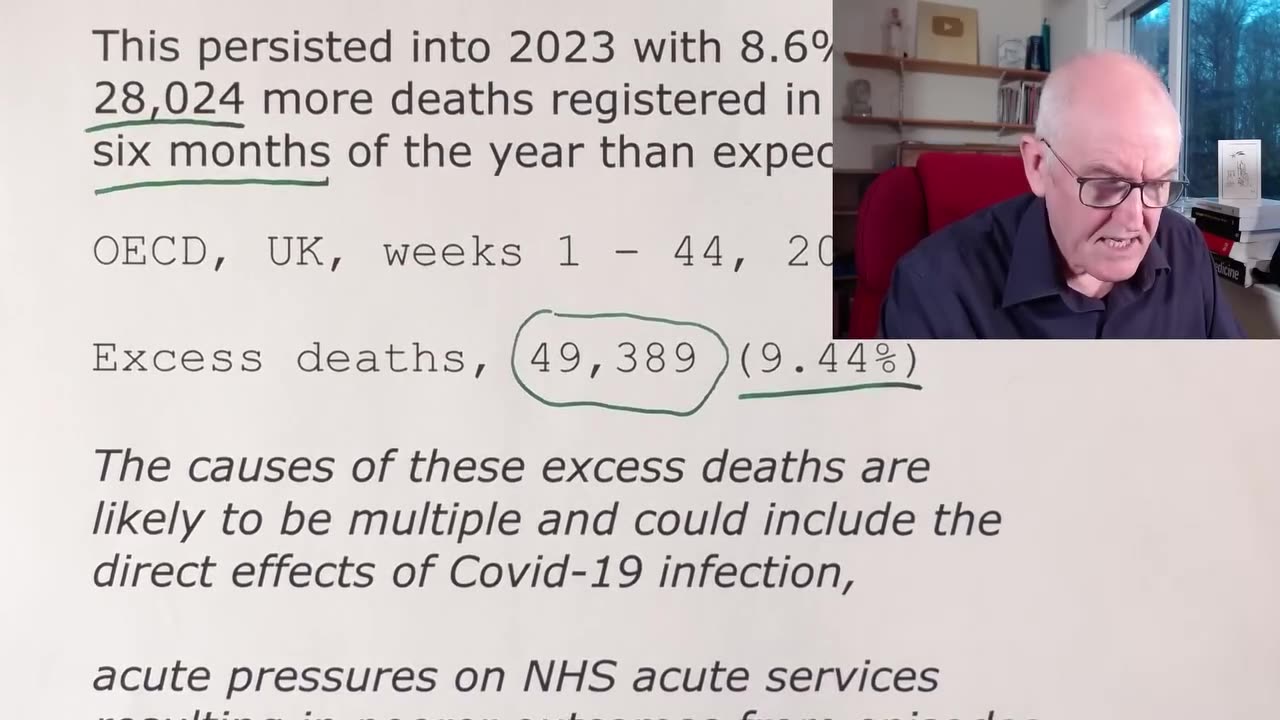Premium Only Content

Excess mortality in England post COVID-19 pandemic: implications for secondary prevention
Excess mortality in England post COVID-19 pandemic: implications for secondary prevention
Many countries, including the UK, have continued to experience an apparent excess of deaths long after the peaks associated with the COVID-19 pandemic in 2020 and 2021.
Numbers of excess deaths estimated in this period are considerable.
The UK Office for National Statistics (ONS) has calculated that there were 7.2% or 44,255 more deaths registered in the UK in 2022
OECD, UK
https://stats.oecd.org/index.aspx?que...
Excess deaths in 2022, 52,514 (9.26%)
This persisted into 2023 with 8.6% or 28,024 more deaths registered in the first six months of the year than expected.
OECD, UK, weeks 1 – 44, 2023
Excess deaths, 49,389 (9.44%)
The causes of these excess deaths are likely to be multiple and could include the direct effects of Covid-19 infection,
acute pressures on NHS acute services resulting in poorer outcomes from episodes of acute illness,
and disruption to chronic disease detection and management.
Further analysis by cause and by age- and sex-group may help quantify the relative contributions of these causes.
Office for Health Improvement and Disparities
3rd June 2022 to 30th June 2023
Excess deaths for all causes were relatively greatest for 50–64 year olds (15% higher than expected)
11% higher for 25–49 and under 25 year olds,
and about 9% higher for over 65s
Several causes
3rd June 2022–30th June 2023
All cardiovascular diseases, 12%
Heart failure, 20%
Ischaemic heart disease, 15
Liver diseases, 19%
Acute respiratory infections, 14%
Diabetes, 13%
For middle-aged adults (50–64)
Cardiovascular diseases, 33% higher than expected
Ischaemic heart disease, 44%
Cerebrovascular disease, 40%
Heart failure 39% higher
Deaths involving acute respiratory infections, 43% higher
Diabetes, deaths were 35% higher
The pattern now is one of persisting excess deaths which are most prominent in relative terms in middle-aged and younger adults
Timely and granular analyses are needed to describe such trends and so to inform prevention and disease management efforts.
JP-S is Partner at Lane Clark & Peacock LLP, Chair of the Royal Society for Public Health and reports personal fees from Novo Nordisk and Pfizer Ltd outside of this submitted work.
Many countries, including the UK, have continued to experience an apparent excess of deaths long after the peaks associated with the COVID-19 pandemic in 2020 and 2021.
Numbers of excess deaths estimated in this period are considerable.
The UK Office for National Statistics (ONS) has calculated that there were 7.2% or 44,255 more deaths registered in the UK in 2022
OECD, UK
https://stats.oecd.org/index.aspx?que...
Excess deaths in 2022, 52,514 (9.26%)
This persisted into 2023 with 8.6% or 28,024 more deaths registered in the first six months of the year than expected.
OECD, UK, weeks 1 – 44, 2023
Excess deaths, 49,389 (9.44%)
The causes of these excess deaths are likely to be multiple and could include the direct effects of Covid-19 infection,
acute pressures on NHS acute services resulting in poorer outcomes from episodes of acute illness,
and disruption to chronic disease detection and management.
Further analysis by cause and by age- and sex-group may help quantify the relative contributions of these causes.
Office for Health Improvement and Disparities
3rd June 2022 to 30th June 2023
Excess deaths for all causes were relatively greatest for 50–64 year olds (15% higher than expected)
11% higher for 25–49 and under 25 year olds,
and about 9% higher for over 65s
Several causes
3rd June 2022–30th June 2023
All cardiovascular diseases, 12%
Heart failure, 20%
Ischaemic heart disease, 15
Liver diseases, 19%
Acute respiratory infections, 14%
Diabetes, 13%
For middle-aged adults (50–64)
Cardiovascular diseases, 33% higher than expected
Ischaemic heart disease, 44%
Cerebrovascular disease, 40%
Heart failure 39% higher
Deaths involving acute respiratory infections, 43% higher
Diabetes, deaths were 35% higher
The pattern now is one of persisting excess deaths which are most prominent in relative terms in middle-aged and younger adults
Timely and granular analyses are needed to describe such trends and so to inform prevention and disease management efforts.
JP-S is Partner at Lane Clark & Peacock LLP, Chair of the Royal Society for Public Health and reports personal fees from Novo Nordisk and Pfizer Ltd outside of this submitted work.
-
 LIVE
LIVE
Russell Brand
46 minutes agoControl Slipping: Germany’s Vote, Ukraine, Apple, and Joy Reid – SF543
5,361 watching -
 LIVE
LIVE
Winston Marshall
27 minutes ago“They Were Hiding THIS!” Michael Shellenberger UNCOVERS Dark Secret About USAID and The Deep State
877 watching -
 LIVE
LIVE
Michael Franzese
23 hours agoAmerica’s Biggest Issues EXPOSED by Tomi Lahren
709 watching -
 55:46
55:46
The Dan Bongino Show
3 hours agoChange Is Coming, And All The Right People Are Panicking (Ep. 2430) - 02/25/2025
382K1.16K -
 1:11:08
1:11:08
The Rubin Report
1 hour agoTimothée Chalamet Stuns Crowd with Speech Pushing This Conservative Value
9.01K13 -
 LIVE
LIVE
Benny Johnson
1 hour ago🚨Deep State DESTROYING Evidence!? FBI Caught DELETING Files, Epstein List COVERUP | Investigate NOW
13,309 watching -
 2:00:34
2:00:34
Steven Crowder
3 hours ago🔴 False Reality: What Joy Reid's Firing Exposes About The Left
240K226 -
 1:34:39
1:34:39
Tucker Carlson
23 hours agoLuke Gromen: Why the CIA Doesn’t Want You Owning Gold, & Is Fort Knox Lying About Our Gold Reserve?
113K193 -
 1:03:56
1:03:56
Timcast
2 hours agoRachel Maddow SLAMS MSNBC As RACIST For Firing Joy Reid, Liberal Media HAS COLLAPSED | Timcast LIVE
50.9K43 -
 DVR
DVR
Bannons War Room
7 days agoWarRoom Live
1.73M339